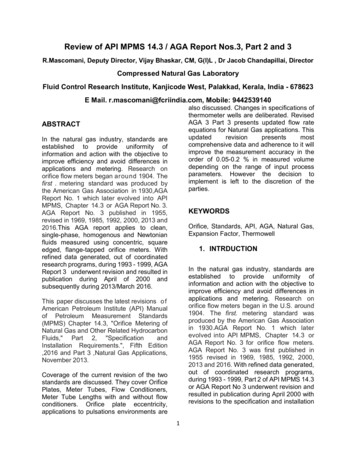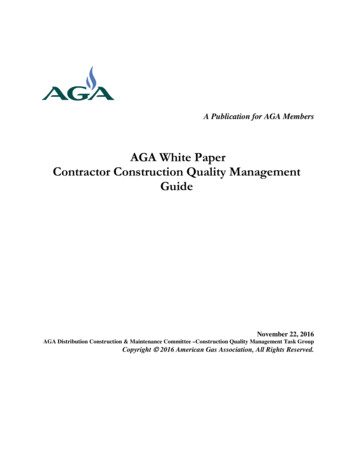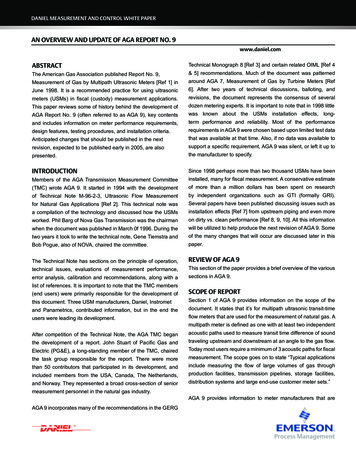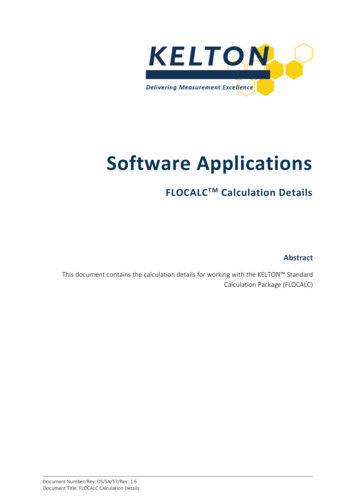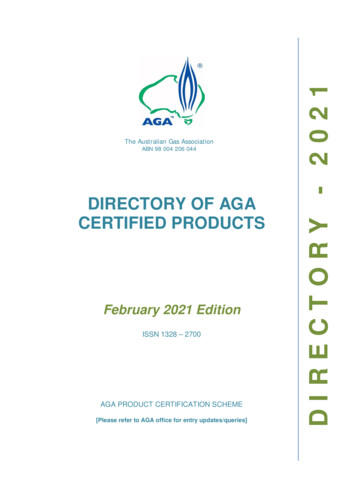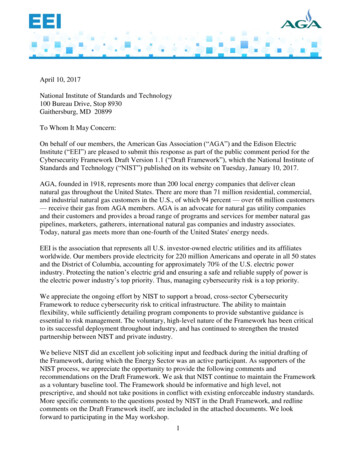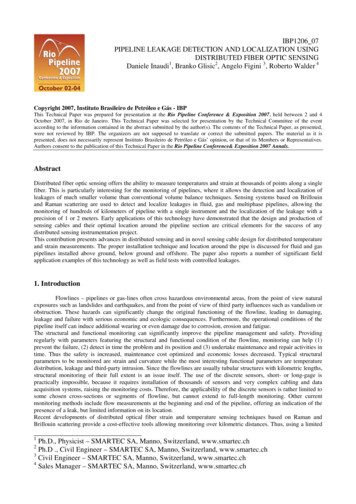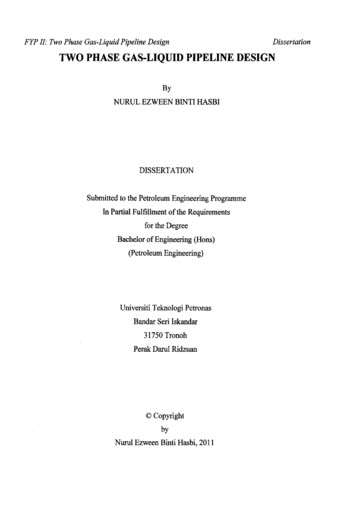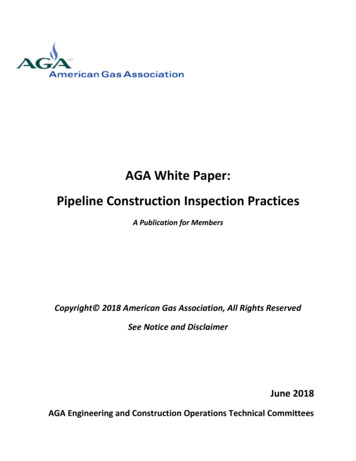
Transcription
AGA White Paper:Pipeline Construction Inspection PracticesA Publication for MembersCopyright 2018 American Gas Association, All Rights ReservedSee Notice and DisclaimerJune 2018AGA Engineering and Construction Operations Technical Committees
DISCLAIMER AND COPYRIGHTThe American Gas Association’s (AGA) Operations and Engineering Section provides a forum for industry expertsto bring their collective knowledge together to improve the state of the art in the areas of operating, engineeringand technological aspects of producing, gathering, transporting, storing, distributing, measuring and utilizingnatural gas.Through its publications, of which this is one, AGA provides for the exchange of information within the natural gasindustry and scientific, trade and governmental organizations. This publication is intended for the scientificcommunity and discussion purposes. Many AGA publications are prepared or sponsored by an AGA Operationsand Engineering Section technical committee. While AGA may administer the process, neither AGA nor thetechnical committee independently tests, evaluates or verifies the accuracy of any information or the soundnessof any judgments contained therein.AGA disclaims liability for any personal injury, property or other damages of any nature whatsoever, whetherspecial, indirect, consequential or compensatory, directly or indirectly resulting from the publication, use of orreliance on AGA publications. AGA makes no guaranty or warranty as to the accuracy and completeness of anyinformation published therein. The information contained therein is provided on an “as is” basis and AGA makesno representations or warranties including any expressed or implied warranty of merchantability or fitness for aparticular purpose.In issuing and making this document available, AGA is not undertaking to render professional or other servicesfor or on behalf of any person or entity. Nor is AGA undertaking to perform any duty owed by any person or entityto someone else. Anyone using this document should rely on his or her own independent judgment or, asappropriate, seek the advice of a competent professional in determining the exercise of reasonable care in anygiven circumstances.AGA has no power, nor does it undertake, to police or enforce compliance with the contents of this document.Nor does AGA list, certify, test or inspect products, designs or installations for compliance with this document.Any certification or other statement of compliance is solely the responsibility of the certifier or maker of thestatement.AGA does not take any position with respect to the validity of any patent rights asserted in connection with anyitems that are mentioned in or are the subject of AGA publications, and AGA disclaims liability for the infringementof any patent resulting from the use of or reliance on its publications. Users of these publications are expresslyadvised that determination of the validity of any such patent rights, and the risk of infringement of such rights, isentirely their own responsibility.Users of this publication should consult applicable federal, state and local laws and regulations. AGA does not,through its publications intend to urge action that is not in compliance with applicable laws, and its publicationsmay not be construed as doing so.Changes to this document may become necessary from time to time. If changes are believed appropriate by anyperson or entity, such suggested changes should be communicated to AGA in writing and sent to: Operations &Engineering Section, American Gas Association, 400 North Capitol Street, NW, 4th Floor, Washington, DC20001, U.S.A. Suggested changes must include: contact information, including name, address and anycorporate affiliation; full name of the document; suggested revisions to the text of the document; therationale for the suggested revisions; and permission to use the suggested revisions in an amendedpublication of the document.1
Copyright 2018, American Gas Association, All Rights Reserved.AcknowledgementsThose who made significant contribution for development of this technical paper are listed below:Mike O’Shea, Xcel Energy Inc.Pierre Bigras, Pacific Gas and ElectricMatt Esmacher, Washington GasRick Esposito, EN EngineeringGeoffrey Ford, CenterPoint EnergyKarl Reer, Central Hudson Gas and ElectricDave Klimas, EN EngineeringJulie Pischulla, Dominion Energy OhioDavid Shipley, Patrick EngineeringJeff Webb, Avista UtilitiesAbstractThis document may serve as a resource for natural gas operators to facilitate management, training, fieldpractices and documentation for inspection of distribution and transmission pipeline constructionprojects. The white paper covers four sections including inspection resources, certification, field tasks,and records management. Each section provides an overview of the current state of the industry followedby guidance to effectively utilize inspection resources to aid in meeting regulatory requirements andindustry specifications for the regulatory purpose of safe and reliable pipeline construction.2
Table of ContentsIntroduction4Inspection Resources6Inspection Certification9Sample Inspector Experience and certificationsInspection Tasks1620Pre-construction inspection tasks21Inspection tasks during construction23Post construction inspection tasks32Inspection Records Management33Appendices38Appendix A: Regulatory Agencies Involved in permitting a gas pipeline project36Appendix B: Natural Gas Pipeline – Local, State and Federal permit details38Appendix C: Forest Preservation Permits44Appendix D: Private Property Easements, Utility Right of Ways, and UtilityEncroachment Agreements45Appendix E: Example form to fill out when an outside agency visits a pipelineConstruction site46Appendix F: Pipeline Construction Documentation checklist473
IntroductionInspection serves a fundamental quality assurance function for the installation of distribution andtransmission gas pipelines. In spring of 2016, the AGA Engineering Committee conducted a survey toassess how companies are managing the pipeline construction inspection process and determine practicesthat could benefit AGA member companies. Several papers have been written by AGA committees andother natural gas focused associations addressing various components of the inspection process. Thegoal of this whitepaper is to provide a document that complements previous efforts. Reference paperssubmitted previously include:AGA Committee Whitepapers AGA Guidelines for Oversight of Construction for Transmission Pipeline, Distribution Mains andServices – Published in April 2013 Developing and Implementing a Quality Assurance Program for Natural Gas Operations –Published in November 2015 Contractor Construction Quality Management Guide- Published in November 2016Other AssociationsINGAA (Interstate Natural Gas Association of America), CEPA (Canadian Energy Pipeline Association), andAPI (American Petroleum Institute) have also proactively made efforts towards establishing guidelines andjob requirements/certifications A Practical Guide For Pipeline Construction Inspectors – March 2016 API 1169 Pipeline Inspector Certification Program – July 2013Membership SurveySurvey questions were comprised of five categories:1. Inspection Resources2. Inspection Certification3. Inspection Tasks4. Decision Making and Accountability5. Inspection Records ManagementThere were a total of 62 questions submitted to AGA member companies. The results varied significantlybased on what type of natural gas system each company operated and each company’s individualexperiences. Companies performing solely services or distribution work generally incorporated lessrestrictive practices adopting a high-level approach towards inspection. Companies involved in more highprofile, gas transmission projects had more regimented inspection programs.The purpose of this white paper is to summarize for AGA member companies:1. Pipeline inspection processes and the role of the inspector to provide effective oversight2. Inspection resources to consider based on project type and complexity3. Consideration of certification requirements/resources and typical skillsets/guidelines to properlyassess field situations and help meet compliance requirements4. Typical tasks involved that an inspector may perform to properly conduct the role5. Suggested documentation to collect as asset records during construction milestonesInspection for pipeline construction involves the examination, checking, observation, investigation, andrecognition of a nonconformance compared to company specifications. The expectation of each functionis subject to the discretion of an individual or company’s interpretation. Inspectors can provide oversighton the culmination of these activities to yield a quality end product, ultimately enhancing safety to the4
natural gas industry. Safety resides with those involved in the construction and maintenance process andultimately the natural gas operator.Quality originates at the conceptual stages of a pipeline project through design and engineering, ontoconstruction and testing and later throughout the operating life. Assets designed to provide decades ofcontinuous service with safe and reliable operation can benefit from a thorough inspection plan duringconstruction.The inspector serves a key role for verifying a quality product is delivered according to industry, regulatoryand company requirements. As requirements change and increase, so does the need for trained andexperienced subject matter experts. Depending on the design complexity and industry regulations aproject may require multiple resources to effectively implement a safe and reliable natural gas system.Materials used during Distribution and Transmission construction vary, thus creating risk factors that varyamong the types of pipeline projects. Managing and monitoring key tasks requires a different strategy,level of oversight and skillset. Having the right amount of inspection resources with the proper skill setsis important in managing a pipeline system.At a high-level, inspectors are expected to monitor job safety and standards and environmentalcompliance, observe and document construction activities and create/complete documentation forcompany records, validate materials, interact with the public, and validate contractor daily logs. Whendiscrepancies arise during a project, differences in interpretation to scope can be resolved between theinspector and the construction leadership. When issues are not readily reconciled, inspectors should havea defined escalation process. An escalation process can require the inspector to report unresolved issuesto their supervisor, for purposes of reviewing and providing guidance to move the job forward. Escalationprocesses should include notifications whenever there are inquiries from public officials or members ofthe media. An inspector notifying a supervisor of public engagement allows appropriate members ofmanagement or public relations to represent the Operator during construction process. The range ofauthority varies among companies but in general when safety is concerned, inspectors shall haveauthority to stop work on a job to address any unsafe work practices. The Operator has ultimateresponsibility for compliance to the Operator’s standards and scope of work. But it is the primary role ofthe inspector to provide the necessary oversight to make sure this happens. To prevent work stoppages,a clear line of communication between the construction leadership and the inspector regarding workplans and activities should be encouraged.Inspectors should have an appropriate level of training or experience with the requisite knowledge, skillsand abilities to complete assigned inspection tasks. Training may include: on-the-job training, classroominstruction, demonstrations or company specific Operator Qualification certification. An effectiveinspection program can facilitate knowledge transfer from highly experienced to less experienced fieldcrews while providing adherence to company standards in areas such as welding, coating, tapping pipe,pipe installation and strength testing.In addition, the natural gas industry has experienced a number of events that make new pipelineconstruction challenging such as: Regional shortages of qualified resources within companies and within local demographics.Increased demand for resources in workforce development.Limited experience within available resource labor pools5
Increased regulatory requirements emphasizing records documentation, environmentalmanagement and safety.Increased demand of pipeline construction for new design and distribution replacement projects.Inspection ResourcesAGA member companies surveyed at the outset of this effort stated their preference is to fill generalinspection positions internally. However, due to the lack of adequate resources for specialized inspectionskill sets these positions are often contracted through a third party. An example of the Inspection areaswhere companies have found success in managing the quality of the process and the end product are thefollowing: Chief Inspector: Leader of inspection team. Knowledgeable of all aspects of the constructionprocess. Provides oversight and coordinates activities of other inspectors on the project.General Utility Inspector: Pipeline inspection, and ROW expertise on the installation of largetransmission lines. Inspectors certified with API 1169.Material Inspector: Receiving and issuing materials to the contractor. Addressing defects beforefield receipt and verifying pipe MTR’s (Mill Test Reports).Welding Inspector: Weld Inspection utilizing knowledge of API 1104 including certification withthe American Welding Society (AWS) as a Certified Welding Inspector (CWI).Coating Inspector: Checking pipe surface profiles. Observing the application processes andverifying the mill thickness of the coating on joints.Electrical Inspector: Knowledge and management of potential critical locations that can causeelectrical interference with a pipeline and knowledge of proper electrical code compliance onthe installation of aboveground facilities. Knowledge of Arc Flash Studies.Structural Engineer: Inspection of deep trench shoring in urban environments.Drilling Inspector: Drilling inspection including river crossings, water ways, bore profiles, pipestress analysis.Environmental Inspector: Knowledge when entering sensitive wetlands, water and siltmanagement, ROW and permit control.Onboarding Inspection ResourcesSuccessful implementation of an inspection program takes a collaborative approach from multipledepartments such as Sourcing (Procurement, Contracts, and Purchasing) to issue contracts andOperations and/or Engineering (Design, Construction) to specify requirements and set expectations.Inspection roles can be filled through different approaches. In a staff augmentation approach thecompany hires a third party to provide candidates managed under the daily direction and oversight of thecompany. Another approach is to hire a third party to provide inspection where the inspectors aremanaged by the third party company ensuring performance and deliverables as defined in the contractrequirements.For example, when an Operator chooses to use a third party for inspection a request for proposal (RFP) istypically issued to third party contractors. The RFP will include defined roles and responsibilities createdfrom Operations and/or Engineering. Upon award of a contract the third Party contracting companywould screen resumes to match candidate’s skills against the stated requirements. Resumes would beprovided for technical positions and filled with specialized skilled employees based on the defined roles.Included in the review process would be evaluation of employee qualifications, certifications, experienceand references on previous project performance. Finally, when onboarding personnel it is important to6
match skillset and capabilities to project needs. This can be a quick review of the resume with a phoneinterview to additional onsite interviews with key internal stakeholders to ensure the candidate canperform in the capacity the company requires. Factors to consider include the complexity and risk levelof the project, previous knowledge and experience of the candidate and the reputation of the third partycontracting company.The majority of the companies (60%) that responded to the AGA member survey do not utilize projectengineers for inspection. Engineers are instead utilized in project management roles focusing on scheduletracking and financial aspects of the project creating a separation of duties and responsibilities. Companyexpectations for inspection vary based on the complexity of the job. Fundamental expectations ofinspectors included:a. Tracking material installed against the bill of materials specified for proper receipt and materialrecords validation.b. Holding the general contractor and various sub-contractors accountable to company standardsand specifications defined in the scope of work.i.Includes validating contractor OQ certification prior to work commencingc. Track project status and record daily progress against tasks.d. Daily time keeping or construction unit tracking.e. Review and verify the accuracy of as-built drawings.Inspection Resource LevelsThe average ratio of projects to inspectors from the committee survey results was 2.6:1. The majority ofthe companies responded that their preferred ratio was 1:1 implying a dedicated inspector for everyproject. However, complex projects may validate the need to assign multiple inspectors covering differentdisciplines to mitigate the risk of quality defects going unnoticed.The need for Inspection resources is influenced by the experience, knowledge and quality of the pipelinecontractor, the proximity of projects located nearby, the complexity of the installation and the scope (pipediameter and length) of the projects. Large gas transmission projects, for example, may requirespecialized inspection resources for welding, coating, boring, deep trenching and environmentalmanagement in addition to assigning a chief inspector to manage the inspection team.Smaller scale construction projects such as small diameter PE main or PE service installations may onlyrequire one inspector to cover multiple projects at a time if they are located geographically near eachother and the contractor has a proven history of quality performance and conforming to companyspecifications.Inspection TeamThe ideal team is one that can effectively manage the oversight of a project to implement installation in asafe, reliable, quality manner, under company specifications and regulatory compliance, along withmanaging project finances properly. Inspection team composition should be scalable for distributionprojects to more complex transmission projects. A department may have several utility inspectors thathave a well-rounded background in natural gas operations. One inspector may watch multiple crewssimultaneously. Project scope is straightforward consisting of smaller main installations and/or serviceswith a relatively low degree of risk. Inspector training is managed internally thru training and OQ7
qualification programs. The utility inspector and the projects are supported by other departments withinthe company.For example, a distribution team can involve multiple inspectors depending on factors such as: Environment (urban vs rural). Additional inspection may be required for cross bores,directional boring, deep congested trenching etc. Project scope and number of contracting crews involved simultaneously. Company requirements for direct observation and oversight (i.e. inspectors observing fusions,inspectors to review utility crossings to prevent cross bores, inspectors to review excavationdepth and slope, inspectors to observe safe tie-in activity, etc.)Typical Inspection Organization Chart – Roles and areas of expertise scale with scope of projectAdminConstruction ManagerAnalyst or AccountingSupervisor or ProjectManagerProcurement/MaterialHandlingUtility InspectorUtility InspectorSupportResponsibilitiesTrainingQA/QC DeptReal EstateFigure 1: Typical Distribution Project - Natural Gas Inspection TeamA gas transmission inspection team may be comprised of multiple job classifications as shown below. AChief Inspector can provide value in managing the inspection process. The certification requirements aregreater and much more specific to the role and responsibility each inspector has. There could beinspectors for welding, coating, civil/environmental, material, general, boring, any other requiredspecialist inspection that the Construction Manager determines is appropriate.8
Construction/ProjectManagerChief InspectorCertified WeldInspectorCoating InspectorDrilling InspectorGeneral/UtilityInspectorMaterial InspectorFigure 2: Example Construction Project Requiring Multiple Inspection DisciplinesInspection CertificationThe establishment of pipeline inspector experience, qualification and certification requirements isultimately the choice of each pipeline operator. In some cases these requirements may be established bya Regulator. As revealed from the AGA survey, expectations differ broadly across the gas industry fromone operator to another. Some operators prefer inspectors have extensive years of experience, somespecify inspectors have Operator Qualification tests; others require internationally recognized andstandardized professional qualifications (API, AWS, NACE etc.). Some operators have an internalinspection workforce, some utilize primarily contract inspection services and others use a mixed model.Considerations presented in this white paper cover both internal and external inspector qualifications.The industry recognizes that standardization in experience requirements, competency, qualifications andcertifications of inspectors across the natural gas operations can ultimately improve the quality ofconstruction, integrity, reliability and longevity of constructed gas assets as well as the safety of workersand members of the public who live and work near these assets. The extent of adopting industrycertifications versus company practices and training for inspection is ultimately the choice of the operator.An overview of industry certifications is provided for consideration but is not intended to imply a mandate.Natural Gas Industry Inspection CertificationsBelow is a list of certifications that have been recognized within the natural gas pipeline and relatedindustries for eligible journey level pipeline craft inspectors. These internationally recognized competencycertifications are administered by Independent Standards and Certifications bodies.9
Figure 3: Recognized Certifications for Multiple Inspector Types: 11 API 1169 Certification for pipeline inspectors including Chiefs, Leads, Specialty, Distribution andother craft InspectorsAmerican Welding Society - Certified Welding Inspector Certification (AWS CWI) (in addition toAPI 1169) for Welding Inspectors is a recommended certification although many Operators haveWelding Inspectors certified by experience or by company OQ.National Association of Corrosion Engineers Coating Inspection Program (NACE CIP) Level 2 (inaddition to API 1169) for all journey level coating inspectors.API RP1169 Pipeline Construction Inspector– Content, Recommend Practice & Body of KnowledgePipeline Construction Inspectors certified by API RP 1169 standards should have a broad knowledge baserelating to construction of new onshore pipeline. This knowledge base, at a minimum, includes such topicsas inspector responsibilities, personnel and general pipeline safety, environmental and pollution control,and general pipeline construction inspection. The API RP 1169 Pipeline Construction Inspector CertificationExamination is designed to determine if applicants have such knowledge2.To qualify for the recommended practice 100-question multiple choice certification exam, candidates arerequired to have previous work experience, education and/or other related industry certifications.Candidates generally can take the exam with just 2 years of pipeline related experience; additionalexperience may be warranted if non-pipeline related3.1TheINGAA and CEPA Foundations Pipeline Inspector Certification Programs 5-16.pdf2API, Body of Knowledge API-1169 Pipeline Construction Inspector Certification Examination. Retrieved February 26, 2018from http://www.api.org/ ograms/1169 EffectivitySheets and BOKs/1169 BOK Apr-Dec-2017 final-011117.pdf3API, API 1169 Pipeline Construction Inspector Certification Fact Sheet. Retrieved February 26, 2018 fromhttp://www.api.org/ ograms/1169 EffectivitySheets and BOKs/1169 PipelineInspector FactSheet September-2016.pdf10
The API 1169 certification examination is based on content coming from a Body of Knowledge 2 (BOK)made up of the following reference documents. Inspectors are expected to have good working knowledgeof materials contained in the reference documents in whole or strictly the specific relevant sections listedin the body of knowledge.The API Recommended Practice (RP) 1169 contains the following topics:1.2.3.4.General Quality PrinciplesPipeline Construction InspectionPipeline Construction SafetyPipeline Construction Environmental ProtectionNational Association of Corrosion Engineers Coating Inspector Program (NACE CIP) Level 1 Content4:The NACE CIP Level 1 certification covers the technical and practical fundamentals of coating inspectionwork. Students will be prepared to perform basic coating inspections using non-destructive techniquesand instrumentation. The certification consists of a five-day course followed by one day of testing. Noprior pre-requisites are required to qualify for CIP 1, however industry knowledge on coatings isrecommended to be successful in obtaining this certification.CIP level 1 certification course covers the following learning objectives: Give examples of corrosion fundamentals such as properties of a coating, coating classification andmodes of protectionRecognize coating types and curing mechanismsRecall coating specifications including service environments and coating life cycleDifferentiate surface preparation equipment, methods, and standards for abrasive blasting, solventcleaning, and power and manual tool cleaningDifferentiate coating application by type, including brush, roller, mitt, and conventional and airlesssprayDemonstrate inspection proceduresDescribe the role of the inspector –as it applies to safety, ethics, conflict prevention, and decisionmakingTest for environmental or ambient conditions and nonvisible contaminantsUtilize non-destructive test instruments such as wet-film and dry-film thickness gauges and low andhigh voltage holiday detectorsMeasure surface profile using replica tape and anvil micrometers, surface profile comparators, anddigital surface profile gaugesIdentify quality control issues, recognizing design and fabrication defects and coating failure modesUtilize Safety Data Sheets (SDS) and product technical data sheetsDemonstrate the purpose and content of Logbook and report documentation4NACE Course Coating Inspection Program Level 1. Retrieved February 26, 2018, x?id ad9ac603-ad11-db11-953d-001438c08dca11
NACE CIP Level 2 Content5:The NACE CIP Level 2 focuses on advanced inspection techniques and specialized application methods forboth steel and non-steel substrates, including concrete using both nondestructive and destructivetechniques. Surface preparation, coating types, inspection criteria, lab testing, and failure modes forvarious coatings, including specialized coatings and linings are also covered. The NACE program consistsof a five-day training course followed by one day of testing. There is a practical test administered as wellas a separate computer based 100 question multiple choice test. Pre-requisites are two years coatingexperience as well as the NACE CIP 1 certification.The CIP level 2 certification course covers the following learning objectives: Explain advanced corrosion theory as it applies to the role of cathodic protection when used withcoatingsIdentify types of environmental controls, and inspection concerns associated with the use of digitalelectronic hygrometers, data loggers and wind speed monitorsIdentify standards, methods of use, and inspection concerns for centrifugal blast cleaning andwater-jetting equipmentRecognize the importance of surface preparation, application, and inspection of liquid-applied andthick barrier liningsUtilize destructive coating inspection equipment, such as adhesion and hardness testers, pH metersand ultrasonic thickness and eddy-current dry film thickness gaugesRecognize the methods of use, standards and inspection concerns for specialized applicationequipment including plural-component, electrostatic and centrifugal, and hot spray systemsRecall concrete coating techniques, concerns and test instruments used for inspectionIdentify specialized coating techniques and application of non-liquid coatings including powderedcoatings, spray metalizing, hot-dip galvanizing and automated coatings applicationDistinguish between different coating survey techniques, procedures and common coating failuremodesDescribe maintenance coating operations, as well as health and safety concerns in relations to theinspector’s work conditionsAWS CWI Content6:American Welding Society (AWS) Certified Welding Inspector (CWI) Program is a certification achieved bysatisfying the combination of defined education, experience, and/or examination requirements.Certification is
profile, gas transmission projects had more regimented inspection programs. The purpose of this white paper is to summarize for AGA member companies: 1. Pipeline inspection processes and the role of the inspector to provide effective oversight 2. Inspection resources to consider based on project type and complexity 3.

